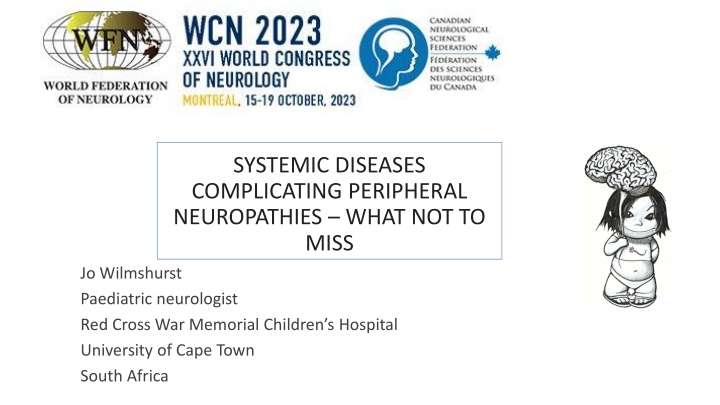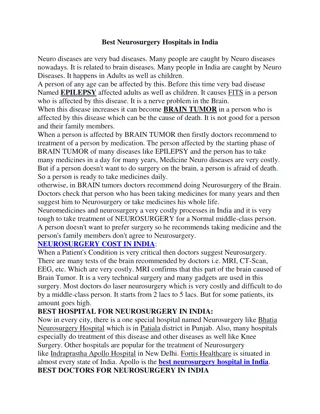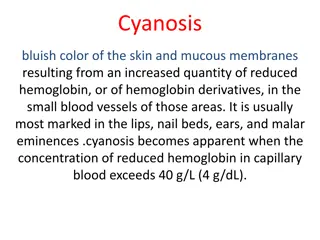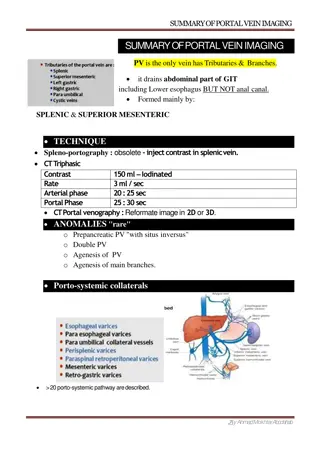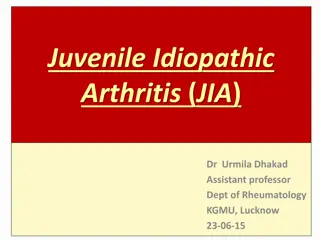Systemic Diseases Complicating Peripheral Neuropathies in Children
Systemic diseases can complicate peripheral neuropathies in children, emphasizing the importance of actively excluding conditions like celiac disease. Early recognition and symptomatic care are crucial for optimal management and improved outcomes. Various systemic disorders may present with co-morbid peripheral neuropathies, highlighting the need for thorough screening and targeted approaches where applicable.
Download Presentation

Please find below an Image/Link to download the presentation.
The content on the website is provided AS IS for your information and personal use only. It may not be sold, licensed, or shared on other websites without obtaining consent from the author.If you encounter any issues during the download, it is possible that the publisher has removed the file from their server.
You are allowed to download the files provided on this website for personal or commercial use, subject to the condition that they are used lawfully. All files are the property of their respective owners.
The content on the website is provided AS IS for your information and personal use only. It may not be sold, licensed, or shared on other websites without obtaining consent from the author.
E N D
Presentation Transcript
SYSTEMIC DISEASES COMPLICATING PERIPHERAL NEUROPATHIES WHAT NOT TO MISS Jo Wilmshurst Paediatric neurologist Red Cross War Memorial Children s Hospital University of Cape Town South Africa
Disclosures Nil
Learning objectives: To understand Systemic disorders with associated peripheral neuropathies Covering Practical common conditions Mainly systemic diseases Not covering infections, genetics specifically or neurometabolic / mitochondrial diseases Critical illness polyneuropathy Chronic renal failure Endocrine disorders Vitamin deficiency states Malignancies and reticuloses Neurofibromatosis, Connective tissue disorders Enteropathy Sarcoidosis.
Key points: What is the relevance? In children with idiopathic peripheral neuropathies, systemic disorders such as celiac disease should be actively excluded. Children may present with neuropathic symptoms as the first indicator of an underlying systemic condition Need to consider this Similarly, some systemic conditions may be complicated by co-morbid peripheral neuropathies surveillance for which is indicated. Some disorders need pre-symptomatic neuropathy screening, while in others there is no benefit from early detection of neuropathy. While management is predominantly focused on symptomatic care through pain control and rehabilitation, some neuropathies improve with effective control of the underlying aetiology and in a small proportion a more targeted approach is possible.
Conclusion Some neuropathies associated with systemic disease can have a profound clinical impact and compromise e.g. CIP and autonomic dysfunction with diabetes mellitus-. Screening for evidence of nerve dysfunction can be an indicator of chronic poor disease control E.g. chronic renal failure Peripheral neuropathy may be the presenting feature warranting active exclusion of the systemic condition. E.g. celiac disease, Early recognition and symptomatic care of neuropathy is important for mobility and pain control. In many conditions, neuropathy will improve in tandem with the optimal management of the underlying disease. Peripheral neuropathies can be associated with a diverse range of medical conditions and unless actively considered may not be recognized and thus inadequately managed.
Key references Critical illness polyneuropathy: Shephard Neurohosp 2017; Field-Ridley Ped Crit Care Med 2016; Cheung et al J Appl Physiol 2021 Chronic renal failure: MendozaGuevara Adv Perit Dialysis 1997 Diabetes mellitus: Hasani J Research Med Sci 2013; Ising PLoS One 2018; Ghaemi Iran J Child Neurol 2018; de Souza D Albuquerque Silva et al Frontiers in Endo 2020; Papadopoulou-Marketou et al Diabetes $ Vascular Dis Research 2021. Vit B1: Mimouni-Bloch Pediatr Neurol 2014; Oguz JPEM 2011; Ortigoza-Escobar Ann Neurol 2017; Han yansel med j 2012;; Salloum Oxf Med Case Rep 2018; Adamolekun Ann N Y Acad Sci 2017;Bottega et al J Hum Genet 2019 Vit B2 (Riboflavin) Balasubramaniam JIMD 2019; James et al Int J Pediatr Otorhinolaryngology 2020; O Callaghan et al JIMD 2019; Chaya Sem Pediatr Neurol 2018; Bosch JIMD 2011; O Callaghan JIMD 2019; Nimmo Am J Med Genet 2018; Manole Brain 2017; Elks Pediatr Neurol. 2023 Jul;144:16-18. Vit B6 (pyridoxine): Vrolijk Toxicol Vitro 2017; Hamel Muscle Nerve 2018; Shetty Paediatr Int Child Health 2018; Baxter DMCN 2001; Ghavanini J Clin NMD 2014; Malek Acta Neurol Belg 2018; Echaniz-Laguna BMJ Case Rep 2018 Vit B12: van Loon Ann Trop Paeds 2009; Grattan-Smith Mov Disord 1997; Dobrozsi Pediatr Blood Cancer 2014; Kalita Nutr Neurosci 2014 Vit E: Chakrabarty J Cys Fibrosis 2013; Ueda J Neurol Sci 2009; Muller Molec Nutr Food Res 2010; Muller Molec Nutri Food Res 2010; Hentati Handbook Clin Neurol 2012; Hooper Curr Atheroscl Rep 2014; Lee JIMD 2014; Di Donato Neurol Sci 2010; El Euch- Fayache Brain 2014; El Euch-Fayache Brain 2014; Malignancies: Bahl Pediatr Blood Canc 2010; Brigo JCN 2012; Apjok Orvosi Hetilap 2003; McLeod Peripher Neurop 1984; Bahl Pediatr Blood Canc 2010; Brigo JCN 2012; Apjok Orvosi Hetilap 2003; McLeod Peripher Neurop 1984; Lavortore Ann Pharmacol 2009; Yang J Am Acad Derm 2015; NF: Antione Lancet Neurol 2007; Gutmann Nat Rev Dis Promers 2017; Park BMC Med 2013; Schulz Exp Neurol 2018; Cheuk Hong Kong Med J 2013; Telleman Clin Neurophys 2017; Farchtschi Muscle Nerve 2017; Patritti-Cram et al Glia 2021 Rheumatoid arthritis: Kaymak Acta reumatol portug 2009; Filatova Zh Nevrol Im SS Korskova 2017; An Clin Rheumatol 2017 SLE: Bhowmik Indian Pediatr 2012; Sarcodosis: Wurzel Pediatr Pul 2009; Rao Pediatr Neurol 2016
